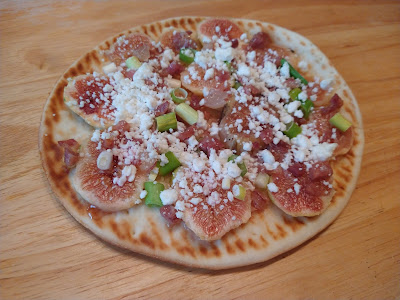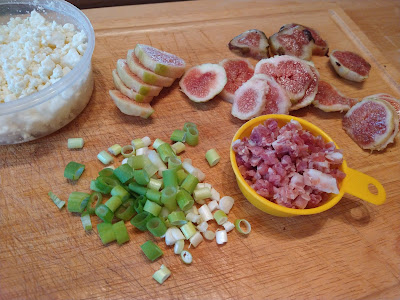
Recipe: Fig, feta and prosciutto pita pizza can be grilled or baked
 |
|
Here's the pizza, hot off the grill. (Photos: Debbie Arrington)
|
Figs need summer heat to ripen. When that summer heat comes in May or June (as it did this year), local figs are ready to pick in early July instead of August.
Right now, Mission figs are turning deep, rich purple. They’re at their peak of flavor when they come off the tree with barely a touch.
So, instead of waiting until Labor Day, we can enjoy ripe figs on the Fourth of July.
This easy recipe makes the most of ripe figs, combining other Mediterranean ingredients – pita bread, olive oil, prosciutto and feta – into fun food for the Fourth or anytime this summer.
Too hot to turn on the oven? This pita pizza works great on the grill, too. And the recipe can be easily multiplied to serve as many people as needed, either as an appetizer or main course – as long as you have enough figs!
 |
| Simple ingredients for a delicious summer pizza. |
Fig, feta and prosciutto pita pizza Makes 1 serving
Ingredients:
1 pita bread
1 teaspoon olive oil
2 ripe figs, peeled and sliced about ¼ inch thick
1 tablespoon chopped scallion
2 tablespoons prosciutto, chopped
2 tablespoons feta cheese
Instructions:
Preheat grill or oven to 400 degrees F.
Lightly brush one side of pita bread with olive oil. Assemble ingredients, placing (in order) fig slices, chopped onion, chopped prosciutto and feta cheese on top, evenly distributed over the pita bread.
Place pita pizza directly on rack of grill or oven. Grill or bake until feta is soft and prosciutto is heated through, about 8 to 10 minutes.
Serve immediately.
Note: To avoid over-cooking bottom of pita bread, grill over indirect heat.
Comments
0 comments have been posted.Sacramento Digs Gardening to your inbox.
Food in My Back Yard Series
April 29: What's (already) wrong with my tomato plants?
April 22: Should you stock up on fertilizer? (Yes!)
April 15: Grow culinary herbs in containers
April 8: When to plant summer vegetables
April 1: Don't be fooled by these garden myths
March 25: Fertilizer tips: How to 'feed' your vegetables for healthy growth
March 18: Time to give vegetable seedlings some more space
March 11: Ways to win the fight against weeds
March 4: Potatoes from the garden
Feb. 25: Plant a fruit tree now -- for later
Feb. 18: How to squeeze more food into less space
Feb. 11: When to plant? Consider staggering your transplants
Feb. 4: Starting in seed starting
Sites We Like
Garden Checklist for week of May 4
Enjoy this spring weather – and get gardening!
* Plant, plant, plant! It’s prime planting season in the Sacramento area. Time to set out those tomato transplants along with peppers and eggplants. Pinch off any flowers on new transplants to make them concentrate on establishing roots instead of setting premature fruit.
* Direct-seed melons, cucumbers, summer squash, corn, radishes, pumpkins and annual herbs such as basil.
* Harvest cabbage, lettuce, peas and green onions.
* In the flower garden, direct-seed sunflowers, cosmos, salvia, zinnias, marigolds, celosia and asters. (You also can transplant seedlings for many of the same flowers.)
* Plant dahlia tubers. Other perennials to set out include verbena, coreopsis, coneflower and astilbe.
* Transplant petunias, marigolds and perennial flowers such as astilbe, columbine, coneflowers, coreopsis, dahlias, rudbeckia and verbena.
* Keep an eye out for slugs, snails, earwigs and aphids that want to dine on tender new growth.
* Feed summer bloomers with a balanced fertilizer.
* For continued bloom, cut off spent flowers on roses as well as other flowering plants.
* Add mulch to the garden to maintain moisture. Mulch also cuts down on weeds. But don’t let it mound around the stems or trunks of trees or shrubs. Leave about a 6-inch to 1-foot circle to avoid crown rot or other problems.